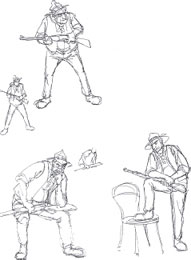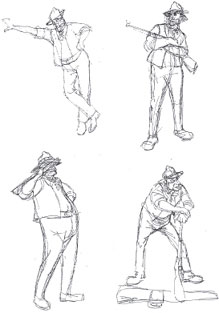A talent for drawing is not enough to be an artist. A deep love for all the aspects of drawing are what it takes to be an artist. One of the chief ingredients of that love is the determination to put your drawing endeavors in the forefront of your daily activities. There is no doubt — let’s hope that you never thought there was — that developing and maintaining your drawing still makes real demands on your time and energy. But one thing is certain, if you truly love something, you never question the time it takes to nurture it be it marriage, hobby, pet, sports, religion, or whatever. It just, simply put, takes a great deal of searching and practice to translate emotions and impressions into visual images.
You nurture your drawing ability by drawing, sketching, and constantly studying drawing. Merely looking at what others have done has a strange psychological effect. True, it is beneficial to have good drawings around to view, but there is a vicarious experience that can’t help but grab you. Unconsciously the feeling creates the impression that you have done something. You aren’t always aware of it but there is a sympathetic kinesthetic feeling or reaction that takes place in your mind and body for nearly every experience you have. It’s very obvious when someone yawns and you respond by yawning. Often when someone or something is about to be hit, on the screen or in real life, you flinch or dodge. While playing or watching sports, you lean forward to help the ball go where you want it to go, or twist and grunt to help a quarterback escape the clutches of a 290-lb tackle bearing down on him. For a moment or two you’re right in the midst of the action. You have the feeling of having experienced it.
There is a similar reaction in the realm of observing drawings. As you look at a drawing (or painting), mentally you go through the motions of doing the drawing yourself. The process is a little more subtle than the physical urging you do while watching sports, but it’s there. It’s possible for you to do enough of that “inner drawing” to satisfy you, to make you feel you have accomplished something, drawn something.
Ultimately it will not be satisfying, for the fact that you have not actually produced a drawing yourself will be a source of great frustration and eventually lead to withdrawal and ennui.
That’s one reason why I place such importance on sketching. It’s fast, it’s economical, and it’s fun. It develops observation, it fosters awareness, and most of all you’re not just observing — you’re actually recording your observations. You’re recording your impressions, which is a most important pursuit for an artist. Remember my formula:
IMPRESSION minus EXPRESSION equals DEPRESSION.
And, of course, the more you draw, the better you become, which gives you confidence, which emboldens you to expand your knowledge, which adds to the pleasure of drawing, which benefits all concerned. And your love for drawing is nurtured and grows. Getting vicarious thrills from looking at other artist’s work is a poor substitute for vigorous self-involvement.
I have reproduced some of James Fujii’s drawings for you; not so you can sit back, relax and feel that something has been done, but so they might inspire you to pursue your own talent with intensified energy. James has studied my suggestions zealously. He would come to class and work on one or two of them each night until he had relegated them to his subconscious, or as he put it, “they became second nature.” On this particular night he worked on angles and on avoiding tangents and also the “story” of the pose. The mime, Ken Martin, modeled for us, and a model sheet of McLeach was taped to the drawing board.
I won’t comment on these drawings — they speak for themselves. But I hope that you will not just enjoy them but will spend some time scrutinizing each of them to study how he avoided tangents and how he worked angle against angle to energize the gesture. Notice the angle of the hat against the face angle, and the shoulder angle; the angle of one arm against the angle of the other arm; the angle of one foot against the other; and the angle of the upper body against the lower. Check all angles against all others. They are very exciting, and provocative.

The small drawings are not my correction drawings, but are James’ experimentation with alternate angles.

